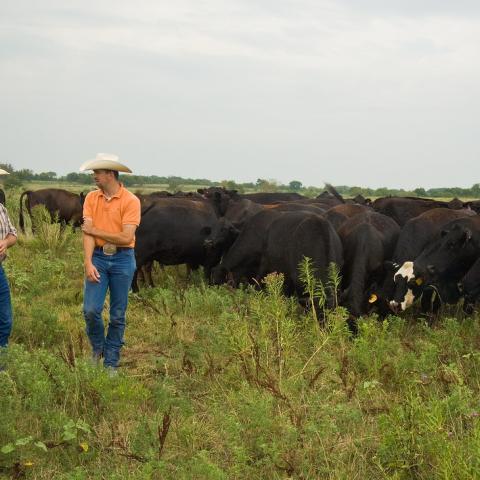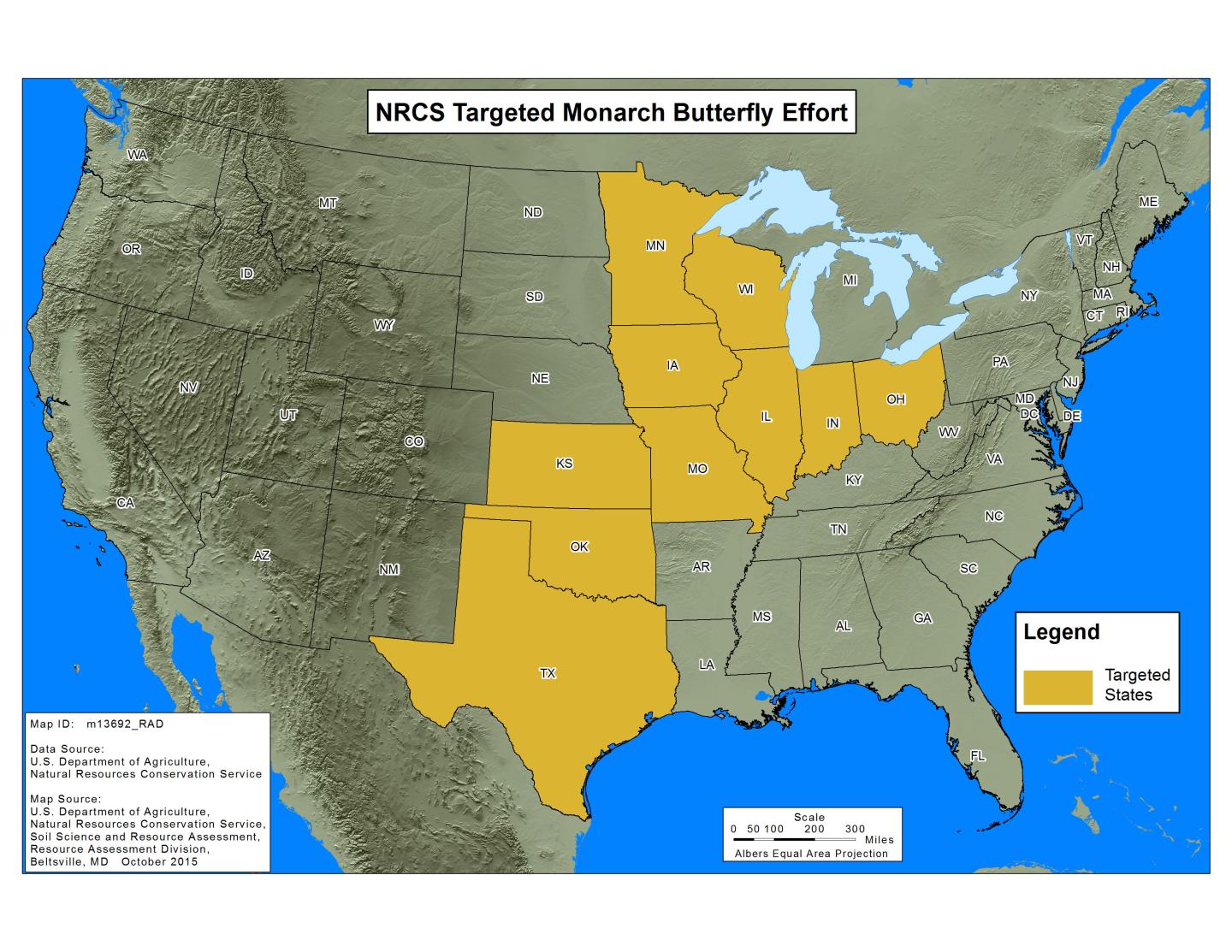
Press Release

The Monarch Butterfly is one of the most familiar butterflies in North America.
The monarch butterfly is one of the most iconic butterflies in North America and is known in part for its annual multi-generational migration from overwintering sites in central Mexico and coastal California to as far north as Canada. Multiple critical population stressors including the loss and degradation of habitat across the species' range have led to a significant decrease in the number of monarchs in the U.S. over the past few decades.
NRCS is working with America's farmers, ranchers, and forest managers on voluntary conservation efforts to combat the decline of monarchs on private lands by establishing new habitat and managing existing habitat for monarchs and pollinators.
The orange-and-black butterfly is known for its annual, multi-generational migration from Mexico to as far north as Canada. Monarch butterflies depend on milkweed to lay their eggs during the journey. But monarch populations have decreased significantly over the past two decades, in part because of the decrease in native plants, including milkweed, on which their caterpillars feed. Agriculture and development have removed much of the native milkweed that once spanned the country. Because monarch butterflies are always on the move, they need to have the right plants at the right time along their migration route. Caterpillars need to feed on milkweed to complete their life cycle, and adult butterflies need the right nectar producing plants in bloom for needed energy.
NRCS is working with agricultural producers in the Midwest and southern Great Plains to combat the decline of monarch butterflies by planting milkweed and other nectar-rich plants on private lands. This region, which includes Illinois, Indiana, Iowa, Kansas, Minnesota, Missouri, Ohio, Oklahoma, Texas and Wisconsin, is the core of the monarch’s migration route and breeding habitat.

Milkweed not only provides food for monarchs, it also supports other pollinators such as honey bees that are vital to agriculture. Milkweed also provides homes for beneficial insects that control the spread of destructive insects.
Meanwhile, NRCS conservation practices that benefit monarch butterflies and other insects also help reduce erosion, increase soil health, control invasive species, provide quality forage for livestock and make agricultural operations more resilient and productive. NRCS provides technical and financial assistance to implement these practices, helping producers improve working lands and strengthening rural economies.
NRCS offers technical and financial assistance to help landowners manage for monarch habitat on farms, ranches and forests. This assistance helps producers plan and implement a variety of conservation activities, or practices, that benefit the monarch, pollinators and many other wildlife species.
Technical assistance is free to producers. The agency’s staff of experts and conservation partners work side-by-side with producers to develop a conservation plan. Each plan focuses on monarch habitat management and is tailored to the producer’s property. These plans provide a roadmap for how to use a system of conservation practices to meet natural resource and production goals. NRCS worked with The Xerces Society for Invertebrate Conservation and butterfly experts across the United States to choose the best milkweed species and nectar producing plants to recommend for landowners. Plant lists are available for producers in the Midwest and southern Great Plains.
With financial assistance from NRCS, producers and conservation partners can plant milkweed and nectar-rich plants along field borders, in buffers along waterways or around wetlands, in pastures and other suitable locations.
NRCS is a nationally identified target species of the Working Lands for Wildlife (WLFW) partnership, a collaborative approach to conserve habitat on working lands. NRCS collaborated with the U.S. Fish and Wildlife Service, enabling the species to be added to the effort in 2017.
Through WLFW, NRCS targets conservation efforts where the returns are highest by targeting the threat of habitat loss. WLFW is able to provide technical and financial assistance through the Environmental Quality Incentives Program, Agricultural Conservation Easement Program and Conservation Stewardship Program, three programs funded through the Farm Bill, the largest funding source for wildlife habitat conservation on private lands.
Instructions for Monarch Butterfly Wildlife Habitat Evaluation Guide and Decision Support Tool: Western Coastal Plain, (PDF, 530KB)
Contact your local service center to start your application.
Do you farm or ranch and want to make improvements to the land that you own or lease?
Natural Resources Conservation Service offers technical and financial assistance to help farmers, ranchers and forest landowners.

To get started with NRCS, we recommend you stop by your local NRCS field office. We’ll discuss your vision for your land.
NRCS provides landowners with free technical assistance, or advice, for their land. Common technical assistance includes: resource assessment, practice design and resource monitoring. Your conservation planner will help you determine if financial assistance is right for you.
We’ll walk you through the application process. To get started on applying for financial assistance, we’ll work with you:
Once complete, we’ll work with you on the application, or CPA 1200.
Applications for most programs are accepted on a continuous basis, but they’re considered for funding in different ranking periods. Be sure to ask your local NRCS district conservationist about the deadline for the ranking period to ensure you turn in your application in time.
As part of the application process, we’ll check to see if you are eligible. To do this, you’ll need to bring:
If you don’t have a farm number, you can get one from USDA’s Farm Service Agency. Typically, the local FSA office is located in the same building as the local NRCS office. You only need a farm number if you’re interested in financial assistance.
NRCS will take a look at the applications and rank them according to local resource concerns, the amount of conservation benefits the work will provide and the needs of applicants. View Application Ranking Dates by State.
If you’re selected, you can choose whether to sign the contract for the work to be done.
Once you sign the contract, you’ll be provided standards and specifications for completing the practice or practices, and then you will have a specified amount of time to implement. Once the work is implemented and inspected, you’ll be paid the rate of compensation for the work if it meets NRCS standards and specifications.